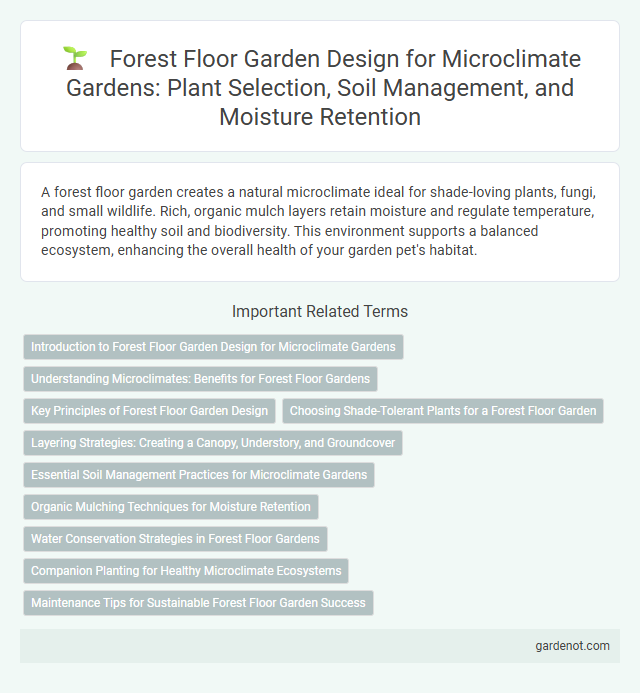A forest floor garden creates a natural microclimate ideal for shade-loving plants, fungi, and small wildlife. Rich, organic mulch layers retain moisture and regulate temperature, promoting healthy soil and biodiversity. This environment supports a balanced ecosystem, enhancing the overall health of your garden pet's habitat.
Introduction to Forest Floor Garden Design for Microclimate Gardens
Forest floor garden design enhances microclimate gardens by creating a layered habitat that mimics natural woodland ecosystems, promoting biodiversity and moisture retention. Incorporating shade-tolerant plants such as ferns, mosses, and ground covers optimizes soil health and shelter, which stabilizes temperature and humidity. Strategic placement of woody debris and leaf litter fosters nutrient-rich soil, supporting microfauna crucial for a balanced microclimate environment.
Understanding Microclimates: Benefits for Forest Floor Gardens
Understanding microclimates is essential for optimizing forest floor gardens, as variations in temperature, humidity, and light under the canopy create unique growing conditions. These microclimates promote biodiversity by supporting shade-tolerant plants and moisture-loving species, enhancing soil health and stability. Recognizing and utilizing microclimate zones allows gardeners to improve plant survival rates and maintain the delicate ecosystem of the forest floor.
Key Principles of Forest Floor Garden Design
Forest floor garden design emphasizes layering native shade-tolerant plants to mimic natural forest ecosystems, enhancing biodiversity and soil health. Key principles include maximizing organic mulch to regulate moisture, selecting species with varied root depths to optimize nutrient uptake, and creating microhabitats that support pollinators and beneficial insects. Integrating decaying wood and leaf litter fosters nutrient cycling, reinforcing the resilience of the microclimate garden.
Choosing Shade-Tolerant Plants for a Forest Floor Garden
Selecting shade-tolerant plants such as ferns, hostas, and wild ginger is essential for a thriving forest floor garden, as these species adapt well to low-light conditions beneath canopy trees. Incorporating native shade-loving plants enhances biodiversity and promotes a balanced microclimate that conserves moisture and enriches soil health. Prioritize species with broad leaves and deep root systems to maximize nutrient absorption and provide ground cover that suppresses weeds and stabilizes the soil.
Layering Strategies: Creating a Canopy, Understory, and Groundcover
Forest floor gardens thrive through strategic layering by establishing a canopy of tall trees that filter sunlight and regulate temperature. The understory, composed of shade-tolerant shrubs and small trees, enhances biodiversity while providing habitat and nutrient cycling. Groundcover plants prevent soil erosion, retain moisture, and suppress weeds, creating a balanced microclimate that supports healthy forest floor ecosystems.
Essential Soil Management Practices for Microclimate Gardens
Forest floor gardens thrive through essential soil management practices that enhance nutrient cycling and moisture retention. Incorporating organic mulches such as leaf litter and wood chips mimics natural forest ecosystems, improving soil structure and fostering beneficial microbial activity. Maintaining a balanced pH and regular addition of compost ensures optimal conditions for root growth and plant health in microclimate garden settings.
Organic Mulching Techniques for Moisture Retention
Organic mulching techniques in microclimate forest floor gardens effectively enhance moisture retention by reducing evaporation and maintaining consistent soil humidity. Materials such as shredded leaves, bark chips, and composted wood act as insulating layers that regulate temperature fluctuations and enrich soil fertility. Applying a 3-5 inch thick mulch layer supports root health, promotes beneficial microbial activity, and suppresses weed growth, optimizing water conservation in shaded, forested environments.
Water Conservation Strategies in Forest Floor Gardens
Forest floor gardens utilize mulch layers, such as leaf litter and organic debris, to retain soil moisture and reduce evaporation effectively. Deep-rooted native plants enhance water infiltration and minimize runoff by stabilizing the soil and promoting natural absorption. Integrating rain gardens and swales within forest floor gardens captures stormwater, enabling gradual water release and supporting resilient microclimates.
Companion Planting for Healthy Microclimate Ecosystems
Forest floor gardens thrive through companion planting, where shade-tolerant species like ferns, hostas, and wild ginger create a layered canopy supporting soil moisture retention and nutrient cycling. Native groundcovers such as mosses and wild strawberries enhance biodiversity and provide habitat for beneficial insects, which helps control pests naturally. This synergistic plant community establishes a resilient microclimate that promotes healthy growth and sustains the forest ecosystem.
Maintenance Tips for Sustainable Forest Floor Garden Success
Maintaining a sustainable forest floor garden requires regular mulching with organic materials such as leaf litter and pine needles to preserve soil moisture and promote nutrient cycling. Monitoring soil pH and ensuring proper drainage prevents root rot and supports native understory plants suited to shaded, acidic environments. Incorporating periodic thinning and careful pruning enhances air circulation, reducing pathogen risks and encouraging healthy growth of shade-tolerant species like ferns, wildflowers, and mosses.
Forest floor garden Infographic

 gardenot.com
gardenot.com